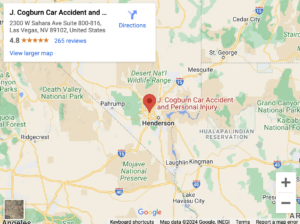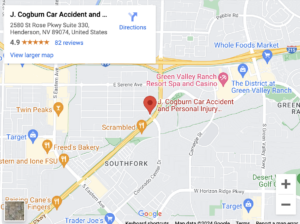
Broken bones are some of the most common injuries seen in accidents, yet their impacts are generally anything but ordinary. A fracture can disrupt your daily life, cause serious pain, and lead you to incur hefty financial burdens.
In Nevada, broken bones are frequently seen in a number of situations, and they leave victims to navigate both physical challenges and the legal implications of being compensated for their damages.
Types of Broken Bones
Also called a fracture, a broken bone occurs when a strong external force exceeds the bone’s strength and causes it to crack or completely break. There are several types of fractures, and each one has varying levels of severity and recovery time.
Some of the more frequently seen types of fractures include the following:
- Simple (Closed): The bone is broken, but it doesn’t pierce the skin
- Compound (Open): The bone breaks and tears through the skin, increasing the chance of an infection
- Comminuted: The bone shatters into three or more pieces, and it often needs surgery to repair
- Stress: Tiny cracks that are usually caused by repetitive strain or overuse
- Greenstick: A partial fracture where the bone bends (often seen in children)
The type of fracture you sustain will determine the kind of treatment it needs and how long it’ll take for you to recover. Some breaks heal simply by keeping the affected area or limb still, but others can’t be mended without surgery, lengthy rehabilitation, and sometimes permanent lifestyle changes.
Common Causes of Broken Bones
Accidents can happen anytime and anywhere, but certain scenarios are more likely to result in fractures. In Nevada, certain types of accidents that cause broken bones are more frequent than others.
These include the following:
Car Crashes
Motor vehicle collisions are a leading cause of broken bones. The incredible force of a crash can often lead to fractures in the arms, legs, pelvis, and ribs, though they can feasibly occur about everywhere else. High-speed crashes tend to cause more severe injuries, including multiple comminuted fractures.
Slips and Falls
Nevada’s bustling urban areas (especially Las Vegas) see their fair share of slip and fall accidents. Wet floors, uneven pavement, and poorly kept stairways or walkways can cause sudden and serious impacts when a person hits the pavement, proving especially damaging to the wrists, hips, and ankles.
Workplace Accidents
Employees in industries like warehousing, construction, and hospitality are particularly vulnerable to bone fractures in Nevada. Falls from substantial heights, heavy machinery accidents, and repetitive stress injuries are often seen throughout these industries.
Recreational Activities
Nevada has plenty of outdoor attractions. From hiking trails to casino resorts, these experiences bring a slew of unique risks to the people who participate. A fall while rock climbing or a slip and fall by the pool can easily lead to a broken bone.
Acts of Violence
Physical altercations and assaults can also cause fractures. Common examples include defensive injuries to the hands and arms or direct blows to the face and ribs.
Treatment and Recovery for Broken Bones
Recovering from a broken bone often requires medical intervention and long-term care. An accurate diagnosis of the type and severity of the fracture is necessary, and that will be provided by way of X-rays, MRIs, and CT scans.
Once the doctor knows what you’re dealing with, they’ll devise a treatment plan for you. In many situations, it will involve the immobilization of the injured area using casts, splints, or braces. Severe fractures might need plates, screws, or rods inserted to hold them in place, and pain management through medication and therapy can help manage discomfort.
After the bone has had a chance to heal, a doctor will likely recommend physical therapy to restore its strength and mobility. The duration and intensity of physical therapy sessions will depend on how badly the bone was broken in the first place.
Many fractures heal completely, and the person is left with no lasting effects. However, others can leave a person with chronic pain, stiffness, limited range of motion, visible deformities, and a higher chance of developing arthritis in the affected area.
The Financial Burden of Broken Bones
The physical and emotional stress of dealing with a broken bone can be overwhelming enough on its own, but that’s without even taking into consideration the costs associated with treating a fracture. Victims are often left with mounting bills for emergency room visits, surgeries, hospital fees, physical therapy sessions, medications, and medical devices.
Additionally, there’s a good chance a fracture victim will miss at least some work while they’re healing. More severe injuries could lead to long-term or permanent disabilities that could leave an individual unable to return to work at all. And the impact of these lost wages can stretch for years.
Legal Considerations
When you suffer a fracture because of someone else’s negligence, Nevada law allows you to file a claim for compensation. Knowing your rights is critical for making sure you’re fairly paid by the responsible party to cover your medical costs, lost wages, pain and suffering, and other damages.
To hold the other person accountable, you need to prove these points to establish negligence:
- They owed you a duty of care
- They breached that duty through their behavior (or lack thereof)
- The breach directly caused your injury
- You suffered damages because of the injury
In Nevada, there’s a statute of limitations during which time you have to file your claim. Typically, the deadline is two years from the day of the injury, though there may occasionally be exceptions. If you don’t file within that timeline, your case could be tossed out, and you might lose your right to collect compensation.
The state follows a modified comparative negligence rule, which means you can still recover damages even if you’re partially to blame for the accident as long as your share of the fault is less than 51%. Your payout, however, will be reduced by your percentage of fault.
Why You Need a Lawyer
Navigating the legal system alone is generally not a good idea, especially for a personal injury case. The law can be confusing and complicated, and insurance companies prefer to minimize their payouts wherever they can. Without legal counsel, they’ll push for you to take an insufficient settlement.
A skilled personal injury attorney can help you level the playing field by performing their own investigation of the accident and collecting the evidence to prove who was at fault. They’ll comb through medical records and talk to experts to get the info they need to strengthen your case, and they’ll negotiate with insurance adjusters on your behalf.
If a fair settlement can’t be agreed on, your lawyer will take your case to court. They’ll compile everything together and present it in the best way possible to improve your chances of a verdict in your favor.
Contact the Las Vegas Personal Injury Lawyers from Cogburn Davidson Car Accident & Personal Injury Lawyers for Legal Help Today
If you’ve suffered a broken bone due to someone else’s careless behavior, contact Cogburn Davidson Car Accident & Personal Injury Lawyers today to schedule a free consultation at 702-996-4786 to discuss your case.


